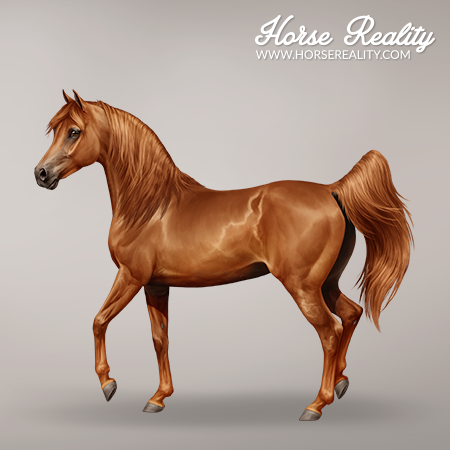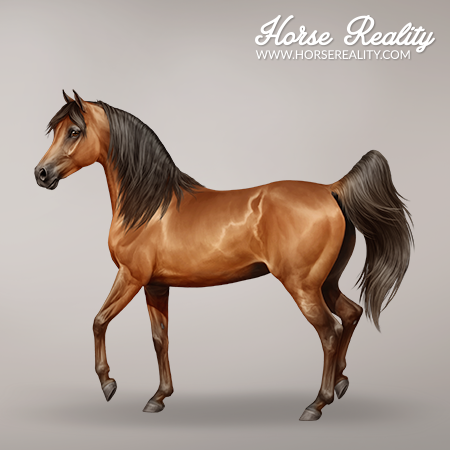There are three different base coat colours that form the foundation for every horse colour out there. Two genes, extension and agouti, work together to determine the base colour: black, chestnut, or bay. In Horse Reality, three types of bay can be differentiated: wild bay, bay and seal brown.
Modifiers and/or dilutions may then act on these bases, creating a wide variety of horse colours.
¶ Phenotype
| Base Colours - Arabian Horse | |
| Example | Information |

|
Black A black horse has an entirely black coat, including the points (mane, tail, lower legs and ear tips). Black can sometimes appear sun-faded with reddish hairs throughout the coat. |

|
Chestnut (red/sorrel) The chestnut colour is defined by a completely red coat with red points. The shade can range from yellowish to looking nearly black. Mane and tail can be the same or a lighter shade than the body. |
| Bay Shades | In Horse Reality, there are three types of bay. Bay horses all have a reddish coat with black points. The shade of the coat and the appearance of these black points distinguish the different types. |

|
Wild bay Wild bay horses can be recognised by their low black points. The black pigment only reaches up to the pasterns or fetlocks of the horse. Their colour usually also has a lighter shade.
|

|
Bay Bay horses have black points on their legs that go up to their knees and hocks. They have a reddish coat, and their shade can vary from a very light mahogany bay to blood bay. |

|
Seal brown Seal brown is a very dark bay coat, sometimes even appearing black. However, areas around the muzzle, eyes, belly and other soft parts are lighter coloured, often more yellowish.
|
¶ Genotype
¶ Extension
The extension gene (MC1R) is responsible for determining whether the hair follicles can produce eumelanin (black pigment) and pheomelanin (red pigment). Pigments get produced by special cells located mostly in the skin - melanocytes. When a certain receptor on the surface of a melanocyte is activated by hormones, it causes the production of black pigment. If the receptor is not activated, melanocytes produce red pigment by default.
The wild-type E-allele allows for the production of both black and red pigment. This allele is dominant to the mutant e-allele. The e-allele causes melanocytes to have inactive receptors, which makes them unable to produce black pigment, resulting in red pigment only.
A horse with the genotype E/E or E/e will therefore be able to produce red or black hair, and it may be black (uniformly distributed black hair) or bay (black restricted to the points) based. Horses with the genotype e/e will always be chestnut-based. The extension gene can be tested at the Laboratory.
- E/E = black or bay-based
- E/e = black or bay-based
- e/e = chestnut-based
In real life, the extension gene is in a linkage group with the KIT locus, but this is NOT a feature in Horse Reality. Linked genes are passed on together as a unit, rather than independently in different combinations. This means that if a horse is E/e SB1/n, for example, it would only pass on either E + SB1 or e + n. The E-allele and the SB1-allele are located next to each other on the same chromosome and therefore passed on together. Passing on e + SB1 or E + n, would be very unlikely. On rare occasions, a “crossing over” event can happen, where the alleles do get recombined and, for example, e + SB1 is passed on after all.
¶
Agouti
The agouti gene (ASIP) controls the distribution of black pigment in the coat. The dominant A-allele blocks the receptors of melanocytes, preventing them from producing black pigment. This results in the production of red pigment instead, and the black pigment gets restricted to just the points of the horse, leading to a bay-based horse. The recessive a-allele allows for black pigment to be expressed over the entire body, resulting in a black-based horse. Agouti only affects horses with an E/E or E/e genotype; since chestnut-based horses (e/e) aren't able to produce any black pigment, agouti has no impact on their colour.
In Horse Reality, three types of bay can be found: wild bay, bay and seal brown. In-game they are each caused by different (dominant) agouti alleles, following an old theory about the genetics behind these types. During the early alpha version of Horse Reality in 2013, there was a laboratory that developed a test for the seal brown allele. Unfortunately, no scientific papers were published and when DNA tests returned with inconclusive results, the test was withdrawn. The real genetic cause for the different bay types still remains undiscovered, and therefore the game still uses this old theory.
Wild bay is caused by the A+-allele of agouti. The “regular” bay shade is caused by the A-allele. Lastly, the allele for seal brown is called At. The recessive a-allele does not restrict the production of black pigment and thus leads to a black-based horse. The order of dominance is as follows: A+ > A > At > a. This gives the following results:
- E/_+ A+/A+ = Wild bay
- E/_ + A+/A = Wild bay
- E/_ + A+/At = Wild bay
- E/_ + A+/a = Wild bay
- E/_ + A/A = Bay
- E/_ + A/At = Bay
- E/_ + A/a = Bay
- E/_ + At/At = Seal brown
- E/_ + At/a = Seal brown
- E/_ + a/a = Black
- e/e = Chestnut
The presence of dominant agouti can be tested at the Laboratory, but the wild bay (A+) and seal brown (At) alleles are hidden and not testable and will be displayed as just A in test results.
¶ References
- Bellone R., Sponenberg D. P., Equine Color Genetics, 4th Edition, 2017, Wiley-Blackwell
- Bowling A, Ruvinsky A., 2000, The Genetics of the Horse, 2000
- UC Davis Veterinary Genetics Laboratory; https://vgl.ucdavis.edu/test/red-factor-horse and https://vgl.ucdavis.edu/test/agouti-horse; Access: November 2022
- Generatio Center for Animal Genetics; https://generatio.de/en/knowledge/basic-genetics/coat-colours-horse, https://generatio.de/en/guidance/lexicon/extension-chestnut-base-colour-e-locus-horse and https://generatio.de/en/guidance/lexicon/agouti-bayblack-base-colour-locus-horse; Access: November 2022